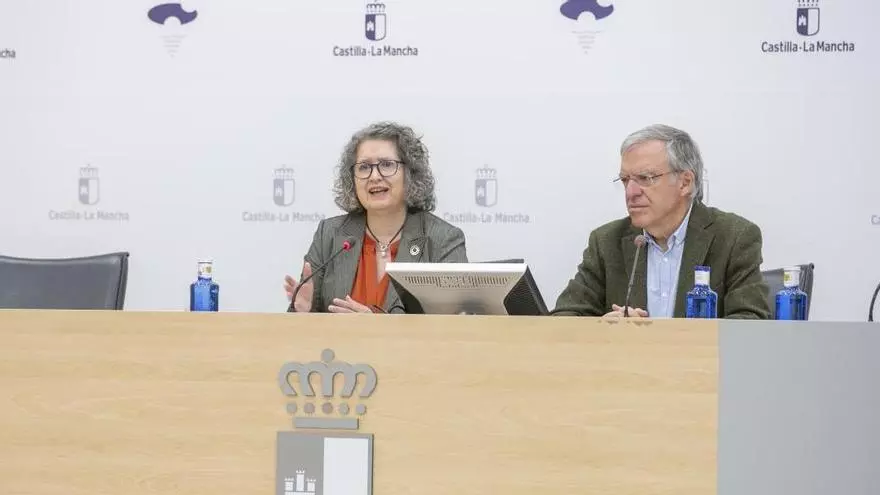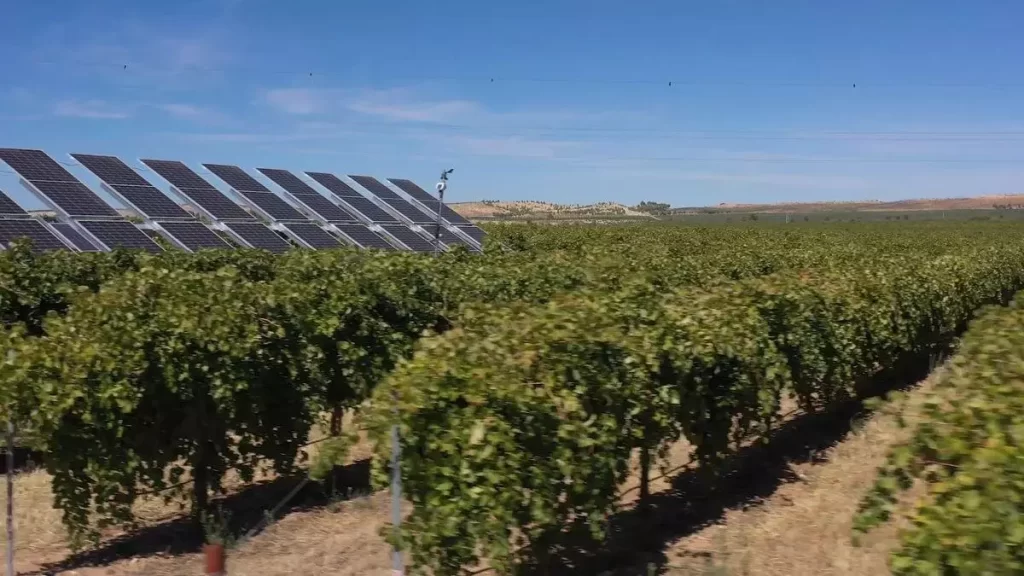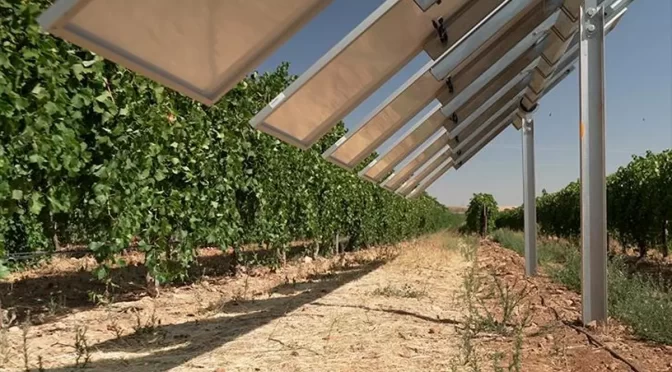Is it possible to unite solar energy parks with agricultural farms? The Spanish Photovoltaic Union is not only committed to this, but it has become a challenge to achieve. This is discussed at the Bioagrovoltaic Conference hosted by the Toledo Regional Administration School.
This is the first edition of this event, which aims to bring society closer to the “double opportunity of combining the practice of organic farming with the production of solar energy.” During the event, the first Bioagrovoltaics Report, prepared by this business association, was presented.
“Photovoltaics is not a problem for the rural world, it is an opportunity.” And he has given as an example the fact that the farmer is given the possibility of choosing between the 300 or 400 euros per hectare that a dry farm offers him, or 1,500 euros per hectare in the rental of that land.
Therefore, with this “we are strengthening the rural world, helping to get out of this crisis.” “We are not a problem, we are part of the solution. We help to establish population, we help to generate wealth, to pay municipal taxes that provide more services to citizens. “Anyone who wants to present it as a problem is seeing the film in the wrong way.”
He concluded by emphasizing that these processes are guaranteed through environmental impact studies and that “the freedom of the owners to choose one way or another” also prevails because “we are not in favor of expropriations.” In any case, city councils must also approve these projects, so they will always have “the approval of local communities.”
This new model has also been defended by the Minister of Sustainable Development, Mercedes Gómez, who has referred to it as a “new framework for action trying to combine agriculture with the use of these lands for the development of photovoltaic parks.”
Four million hectares
In the case of Castilla-La Mancha, there are currently almost four million hectares that can be affected by the implementation of solar parks, so “it is important to see the compatibility of agricultural use and establish alternative systems.”
In this sense, she has highlighted the work of the Institute of Concentrated Photovoltaic Systems (ISFOC) of Puertollano, where solar panels are being developed with transparent polymers that would allow the sun’s rays to pass through them and not shade the crops.
The counselor also recalled that this autonomous community is the main producer of solar energy, a fact from which agriculture can benefit. “A local energy that could cover their needs, a harmony between the use of agricultural land for a photovoltaic park.”
After the celebration of the day, UNEF has organized a guided tour of the Wine Solar Agrovoltaic Project in the Toledo town of Guadamur. This is an initiative that Iberdrola has launched in the vineyards of Grupo Emperador, becoming “the first smart agrivoltaic plant in Spain.”
The meeting, which was opened by the Minister of Sustainable Development, Mercedes Gómez, and José Donoso, general director of the UNEF, also had the participation of companies and public institutions.
Donoso explained that photovoltaic energy requires less than 0.2 percent of Spanish agricultural territory to meet the objectives of the National Integrated Energy and Climate Plan (PNIEC), but “we have always felt that even so we are responsible for the use of that territory.” ”.
For this reason, he said, this photovoltaic employers’ association developed a series of recommendations some time ago that represent a certificate of excellence so that solar plants become “an opportunity for biodiversity, also being a refuge for fauna.”
“Now we wanted to give one more twist and we are looking for how to make photovoltaic parks compatible with agricultural operations, where desired.” For this reason, UNEF has prepared a study, the one presented at the conference, to analyze how to do it.

Mercedes Gómez y José Donoso JCCM
As he detailed, this integration not only means “maximizing employment” by maintaining employment derived from solar parks and, at the same time, agricultural employment, but also seeks to increase crop productivity by fighting climate change. Because in this “bioagrivoltaic” the objective is to “create clean energy in clean agriculture”, that is, in organic crops.
Asked if the current crisis situation in the agricultural sector would be a disadvantage for this objective, José Donoso highlighted that it is “a false dichotomy to say that we have agriculture against photovoltaic energy.”
“Photovoltaics is not a problem for the rural world, it is an opportunity.” And he has given as an example the fact that the farmer is given the possibility of choosing between the 300 or 400 euros per hectare that a dry farm offers him, or 1,500 euros per hectare in the rental of that land.
Therefore, with this “we are strengthening the rural world, helping to get out of this crisis.” “We are not a problem, we are part of the solution. We help to establish population, we help to generate wealth, to pay municipal taxes that provide more services to citizens. “Anyone who wants to present it as a problem is seeing the film in the wrong way.”
He concluded by emphasizing that these processes are guaranteed through environmental impact studies and that “the freedom of the owners to choose one way or another” also prevails because “we are not in favor of expropriations.” In any case, city councils must also approve these projects, so they will always have “the approval of local communities.”
This new model has also been defended by the Minister of Sustainable Development, Mercedes Gómez, who has referred to it as a “new framework for action trying to combine agriculture with the use of these lands for the development of photovoltaic parks.”
Four million hectares
In the case of Castilla-La Mancha, there are currently almost four million hectares that can be affected by the implementation of solar parks, so “it is important to see the compatibility of agricultural use and establish alternative systems.”
In this sense, she has highlighted the work of the Institute of Concentrated Photovoltaic Systems (ISFOC) of Puertollano, where solar panels are being developed with transparent polymers that would allow the sun’s rays to pass through them and not shade the crops.
The counselor also recalled that this autonomous community is the main producer of solar energy, a fact from which agriculture can benefit. “A local energy that could cover their needs, a harmony between the use of agricultural land for a photovoltaic park.”

Iberdrola Wine Solar Project
After the celebration of the day, UNEF has organized a guided tour of the Wine Solar Agrovoltaic Project in the Toledo town of Guadamur. This is an initiative that Iberdrola has launched in the vineyards of Grupo Emperador, becoming “the first smart agrivoltaic plant in Spain.”
These installations allow the arrangement of the modules to be adapted to the needs of the vineyards, to regulate the incidence of the sun and the temperature through the shading of the panels.
The project aims to achieve an improvement in the quality of the grapes, which, according to its promoters, will allow “a more efficient use of the land, will reduce the consumption of irrigation water and will improve the resistance of this crop to climatic conditions, in the face of “increasing temperatures and increasingly frequent heat waves.”
The generation of this plant, of 40 kW, will be used entirely for self-consumption of the Emperador Group wineries, which will thus be able to reduce their emissions, advance in the decarbonization of their activity and reduce their energy costs.


